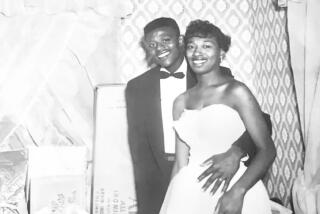Grenada Looks for Closure in a Gravedigger’s Discovery
- Share via
ST. GEORGE'S, Grenada — Where is the body of Maurice Bishop?
That is Grenada’s most haunting and enduring Cold War mystery--and has been since the legendary leftist prime minister was brutally executed, along with about a dozen supporters, in a 1983 government upheaval that triggered the Reagan administration’s invasion of this remote Caribbean isle.
The invading American troops rounded up and jailed 17 soldiers and insurrection leaders for the killings. But to this day, U.S. officials have not acknowledged that Bishop’s body or the remains of those gunned down beside him were ever found.
On New Year’s Eve, however, along came undertaker Clinton Bailey and half a dozen teenagers from a local boys college.
At a year-end news conference that inflamed a long-exposed national nerve, Bailey announced that a gravedigger at St. George’s cemetery, a burly, bearded Grenadian named Michael MacIntosh, had unearthed three U.S. military body bags that might well contain the remains of the late prime minister and some of his missing aides.
If anyone is in a position to say that, it’s the 39-year-old Bailey. His father, Leslie, who ran the Otway/Bailey Funeral Home until his death in 1998, was consigned by the U.S. invasion force to bury several body bags in an unmarked grave 16 years ago, Bailey told The Times last week. His father never revealed the location of that site, he added--not even when Bishop’s daughter, Nadia, searched the cemetery with several U.S. forensic specialists a few years ago.
Last summer, students from Grenada’s Presentation Brothers’ College approached Bailey for help with their class project: tracking down Bishop’s body as an exercise in “nurturing a culture of peace.” Documents, the students said, had led them to Bailey’s door.
A few months later, Bailey said, MacIntosh independently stumbled on the body bags while digging a fresh grave. And in December, Bailey said, after seeing the contents of one bag when MacIntosh dug down to it, he decided to hold the news conference in hopes of clearing his family name after 16 years of suspicion.
But the mystery continues. And Grenada’s renewed search for national closure has touched off a political debate and rekindled the suspicions surrounding the brief U.S. intervention.
Last week, the U.S. Embassy in St. George’s responded yet again to a belief long held by many Grenadians: that U.S. forces found Bishop’s remains soon after the October 1983 invasion but deliberately obscured their disposal to avoid a state funeral and a burial site that could lead to an anti-American backlash by supporters of the Marxist leader and ally of Cuba.
“The U.S. has no information concerning the whereabouts of those remains nor any reason to conceal such information,” the brief statement said.
Prime Minister Keith Mitchell reportedly has asked Washington to send a forensic expert to examine the recent discoveries, which remain under a carpet of jungle vines in a corner of the cemetery now surrounded by crime-scene tape.
But relatives of the dead and leaders of the Maurice Bishop Patriotic Movement political party, who have long distrusted the U.S. government, have made a request of their own: They’ve asked the Cuban Embassy here to bring an independent DNA expert from Havana to oversee the forensic exam.
What is more, Bishop’s supporters suspect that the recent disclosures are related to a renewed effort to free the 17 officials who broke from Bishop’s ranks and were later convicted of staging the executions; their death sentences were subsequently commuted, and all are serving life terms.
“You can’t bring closure to that period unless you release these people and answer the question of what happened to the bodies,” said Grenadian Voice Editor Leslie Pierre, explaining that he’s leading the move to free the 17 because their trial was unfair.
Dr. Terence Marryshow, the Cuban-educated physician who heads the Maurice Bishop Patriotic Movement, insists that the 17 must remain behind bars and argues that a proper burial of Bishop and his backers will be enough to heal Grenada’s lingering wounds.
“When the remains are finally recovered, you will see the biggest funeral that has ever taken place in this country,” he said. “And that will help the stability of this country. . . . As long as these mysteries remain, so does the potential for instability in Grenada.”
More to Read
Sign up for Essential California
The most important California stories and recommendations in your inbox every morning.
You may occasionally receive promotional content from the Los Angeles Times.













